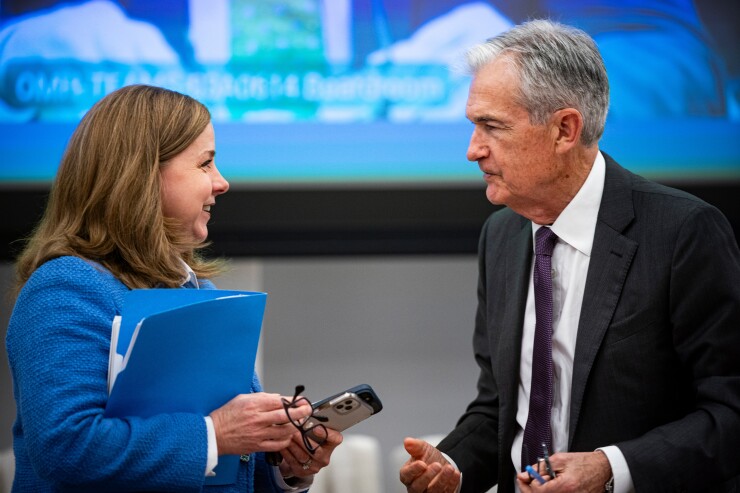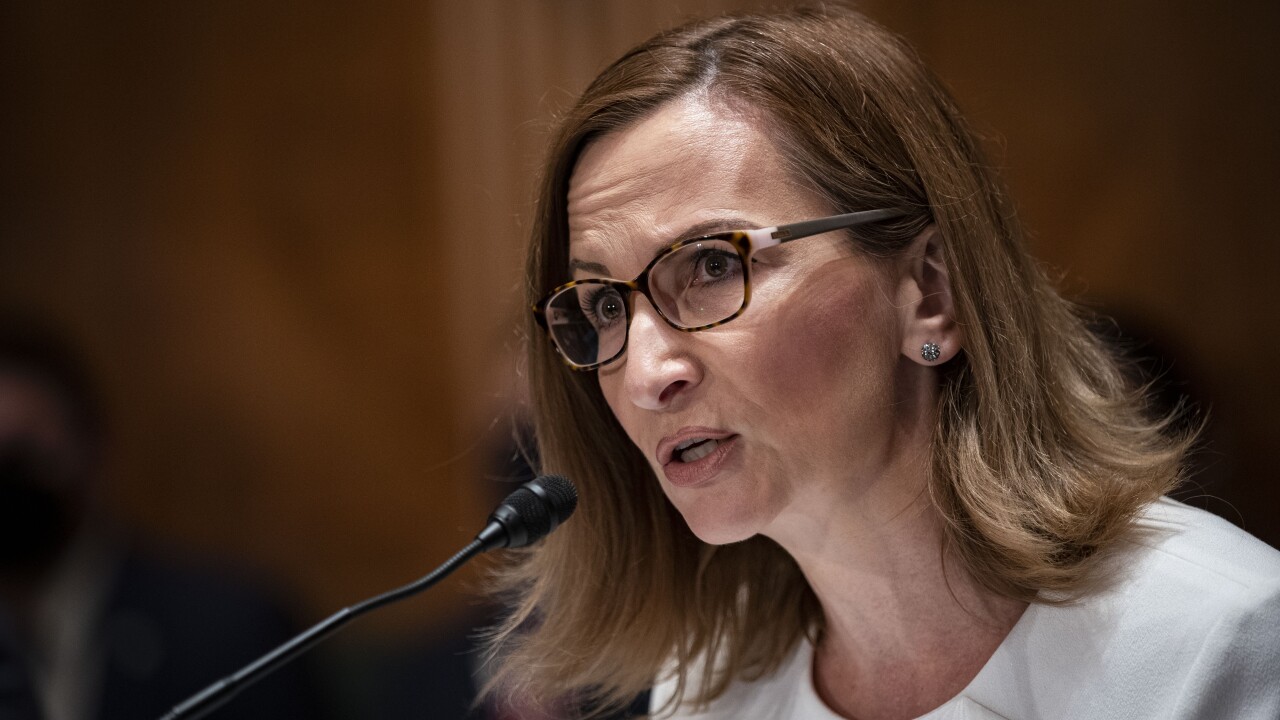
Regulators want banks to do more to support the smooth functioning of the Treasury market. Whether their newest reform effort is the best way to achieve that goal, however, is a matter of debate.
The Federal Reserve, the Federal Deposit Insurance Corp. and the Office of the Comptroller of the Currency have
But some legal observers question whether the changes being considered for the enhanced supplementary leverage ratio, or eSLR, would actually lead to the type of increased intermediation that the agencies are seeking. Others take issue with the use of the regulatory framework for addressing issues not squarely related to banking.
"Is this what the bank regulatory framework should be doing? Is that what it's there for? No. It's for keeping banks safe and sound and able to serve all qualified borrowers," said Jeremy Kress, a University of Michigan law professor. "Trying to set safety and soundness rules with one specific goal in mind of having banks own one specific type of asset isn't the way we've typically thought about capital requirements."
Even so, banks and even some proponents of high regulatory standards say the eSLR is overdue for an update. Since the rule went into effect more than a decade ago, the federal debt has expanded significantly — growing faster than banks' balance sheets. As a result, the requirement has become the primary regulatory standard for which some big banks — specifically those with large trading books — must manage.
Currently, Morgan Stanley, BNY Mellon and State Street are all bound by the leverage ratio, according to data from the large bank advocacy group the Bank Policy Institute. Depending on trading activity, other banks are periodically bound by the eSLR.
Former Fed Gov. Daniel Tarullo, who spearheaded the implementation of the eSLR as part of a broad rethink of bank oversight in the wake of the global financial crisis of 2008, said he and other policymakers worried about the requirement's impact on the Treasury market in 2013.
Since 2015, U.S. debt held by the public has more than doubled, from $18 trillion to more than $36 trillion today. During that same period, assets held by the 25 largest banks in the country have grown at a more modest pace, from nearly $9.5 billion to around $14 billion, according to data tracked by the Fed. In a
"Unlike other possible changes in capital standards, modification of the eSLR has been favored by many advocates of strong overall capital requirements, myself included," he wrote. "The reason is the potential negative impact of the current eSLR on the effective functioning of markets for U.S. Treasuries, as the amount of U.S. debt continues to balloon."
Yet, the emerging debate over the proposed eSLR reform push is whether it would actually spur the nation's largest banks to increase their Treasury market intermediation, or if it will simply free up their balance sheet capacities for
Proponents and skeptics alike agree that the current set of changes under consideration alone would not be enough to fully stabilize the U.S. Treasury market, which has grown more volatile and less liquid in recent years as the federal deficit has skyrocketed.
Banks and their representatives in Washington have for years been calling for the Fed to exclude low-risk assets — such as Treasury securities and reserves held at the central bank — from the SLR. They have not dropped that request, but they say the proposal is a good start.
"eSLR reform isn't a panacea to Treasury market illiquidity, especially if Treasuries and reserves remain in the leverage ratio denominator," said Sarah Flowers, senior associate general counsel of regulatory affairs at BPI. "However, the changes should make a material difference during periods of stress, when the question becomes whether the private sector or the Federal Reserve should step in to intermediate markets. We believe the private sector is better equipped for that role, and these changes make that possible."
Others say the role Treasury market making plays in the leverage ratios is often overstated. Phillip Basil, director of economic growth and financial stability at the regulatory advocacy group Better Markets, pointed to a
In light of this, Basil said he worries that the regulatory relief being offered in the proposal — a 27% decrease in capital requirements at the depository level and a 1.4% reduction at the bank holding company level — will not secure them any additional stability in the Treasury market.
"You're lowering capital requirements with zero guarantee that they're going to intermediate more in markets," said Basil, a former policy specialist for the Federal Reserve Board. "There's clear evidence the banks weren't really taking advantage of [the exemption in 2020]. It wasn't changing anything. At the end of the day, it was capital relief."
Leverage ratio explained
Most banks are subject to some type of leverage ratio, which determines the minimum amount of equity they must hold relative to their assets. Banks with at least $250 billion in assets are subject to a supplementary leverage ratio requirement, meaning their tier 1 equity capital must equal 3% of their on- and off-balance sheet leverage exposures. The eSLR currently adds a 2% capital requirement for the eight largest, global systemically important banks, or GSIBs.
Leverage ratios are risk-blind requirements. They treat all assets the same regardless to measure a bank's indebtedness in the broadest possible terms. In theory, they incentivize banks to chase higher yields through riskier exposures, because there is no capital penalty for doing so. Because of this, regulators prefer the SLR to be a backstop requirement behind risk-based capital requirements, which apply discounts to Treasuries and reserves held at the central bank, as they are viewed as having little or no credit risk.
The nation's largest banks are subject to several sets of capital requirements, each of which have slightly different regulatory minimums and methods for measuring balance sheet exposure. When calibrated correctly, regulators say, a bank's capital holdings will hew closest to one of risk-based requirements.
In mathematical terms, each of these standards divides a bank's equity by its assets. Because the SLR considers the widest breadth of assets — giving it the biggest denominator — it has the lowest minimum ratio at 3% or 5% for GSIBs. Risk-based requirements are calculated based on smaller denominators, so their minimum requirements are higher.
But, the more zero-risk-weighted assets a bank has, the smaller its risk-adjusted denominators become, making it relatively easier to exceed regulatory minimums — and, therefore, more difficult to meet the SLR requirement.
To address this, regulators have proposed removing the 2% eSLR charge with a new charge that equals one half of a bank's GSIB surcharge — a capital requirement imposed on the eight largest banks based on their systemic footprints — to ensure the requirement reflects a bank's overall size, without penalizing for heavy exposures to low-risk assets.
GSIB bank subsidiaries, meanwhile, would face the half-GSIB surcharge instead of their current, 3% eSLR.
For purposes of this new charge, regulators will use what is known as the method 1 calculation for each bank's GSIB surcharge. Typically, the method 1 approach results in a smaller capital add-on than method 2.
The most critical change might be the fact that the proposal would shift the eSLR from being a capital requirement at the depository level to a capital buffer, aligning it with the treatment at the bank holding company level.
This would mean that should a bank fall below its minimum eSLR, it could still face supervisory scrutiny, but it would not be subject to immediate corrective action.
How low will bank capital go?
Another subject for debate is the degree to which the proposal would actually change capital retention at the country's largest banks.
Fed Vice Chair Michelle Bowman said risk-based requirements at the holding company level will keep overall capital levels roughly unchanged.
"These changes at the bank level do not enable them to increase capital distributions to shareholders, as their holding companies would generally remain constrained by risk-based capital requirements," Bowman said in pre-written remarks at an open Fed board meeting last week. "In fact, the GSIB holding companies are required to contribute assets to their bank subsidiaries to cover capital shortfalls, if needed, pursuant to secured support agreements and are subject to general source of strength obligations."
But Fed Gov. Michael Barr disagreed with Bowman's assessments about both capital levels and source of strength mechanisms — through which holding companies are supposed to keep their banking subsidiaries solvent long enough to carry out an orderly resolution.
In his own prepared statement, Barr — the Fed's former supervisory vice chair — said the proposal's corresponding changes to total loss-absorbing capacity and long-term debt requirements compound the effects on capital reduction. He also said that diminishing the impact of the leverage ratio could enable banks to game risk-based capital requirements by "lowering their risk-weighted asset density," either by using
"This kind of gaming of risk-based requirements is precisely what leverage ratios are designed to block," he said.
Barr also cautioned against relying upon the "source of strength" doctrine — where an insured depository can rely on its holding company to be a source of stability and capital in a stress event — noting that strategy failed to prevent the
Meanwhile, banks and their representatives say the capital impact will be even less than what the Fed has projected. In a statement, BPI CEO Greg Baer said the proposal would account for a capital decrease of 0.74%.
"Postulations that it materially lowers capital are misleading, as the proposal restores risk-based capital as the primary constraint," Baer said.
Luigi De Ghenghi, a partner at the law firm Davis Polk, said even the concept that capital would be shifted from depositories to their holding companies is "misplaced," noting that such a transfer would not only face mechanical hurdles — namely that doing so would count as a dividend that would be subject to regulatory approval — but it would also be imprudent management.
"At both the holding company level and bank level, you're still going to manage yourself to these buffers," De Ghenghi said. "It's just that the consequences of not having 100% of your buffer aren't as dire as they are for failing to be well capitalized."
He added that the direct capital relief from the proposed changes would only be enjoyed by the handful of banks that are bound by the eSLR.
"For the banks where the risk-based capital requirements are the binding capital constraints, there will be no relief at all," De Ghenghi said.
Intermediation in question
Various officials, including Treasury Secretary
They point to not only the "dash for cash" in 2020, but dysfunction in the reverse repurchase agreement market
SLR reform is not the first by the federal government to shore up its debt issuance capabilities, nor will it be the last. In 2021, the Fed launched the standing repo facility to serve as a backstop for money market funds. In 2023, the Securities and Exchange Commission passed a rule requiring central clearing for all Treasury securities transactions to bolster market resiliency. That change goes into effect for Treasuries next year and repos the following year.
Changes on the horizon include a potential shift to all-to-all trading — which is what — which would alleviate some of the strain on broker dealers. Even the proliferation of dollar-pegged stablecoins is being pitched as a potential mechanism for bolstering Treasury demand — although that would come with
The stewards of the U.S. financial system are not relying on banks alone to heal the Treasury market's woes. But it remains to be seen how reliable banks will be to the government in its efforts to bolster the market.
De Ghenghi said much will depend on the final version of the new SLR rule. He said banks would still like to see at least some Treasury exposures excluded from the calculation to meaningfully increase their intermediation, noting that some of the alternatives considered in the proposal left the door open to that outcome.
"The regulators have proposed these interesting alternatives that are meant to say, 'OK, we've played with the ratio and made sure that it's a buffer, but we haven't excluded anything from the denominator — and we know that's what a lot of the banks want, some exclusion from the denominator,'" he said. "So we'll see what the comments look like."
Others say regulators should use the comment period to consider just how much additional stability they will get from a less binding leverage ratio and weigh it against the potential instability that could come from a decline in bank capital.
Graham Steele, a former Treasury official and current academic fellow at Stanford Law School's Rock Center for Corporate Governance, said it is well within the Fed's authorities to consider macroprudential threats — such as Treasury market instability — but noted that its tools for addressing those risks extend beyond the bank capital framework.
"They have to make the case about how those things connect up and why this particular route is preferable to using a different tool they might have — like the repo facilities that they have set up to absorb some of the demand, or just Treasury purchases outright," Steele said. "It would be useful to have more discussion of that to unpack why this is the right financial stability measure — deregulating banks — as opposed to using some of the other financial stability tools and authorities they have at their disposal."






